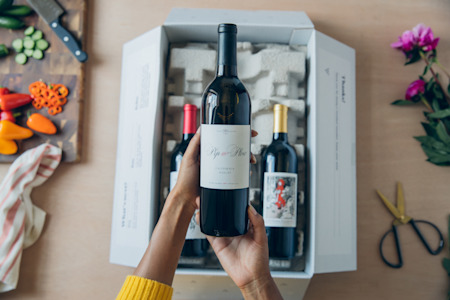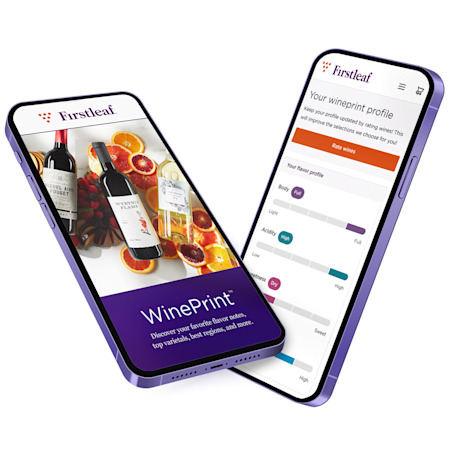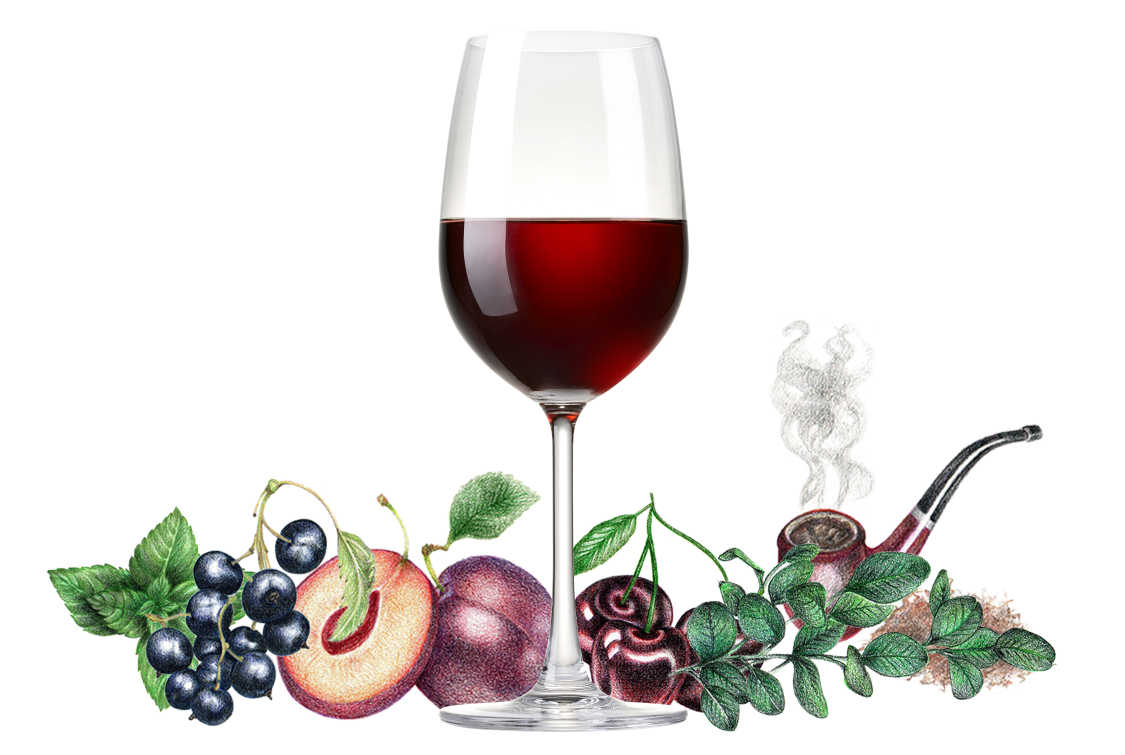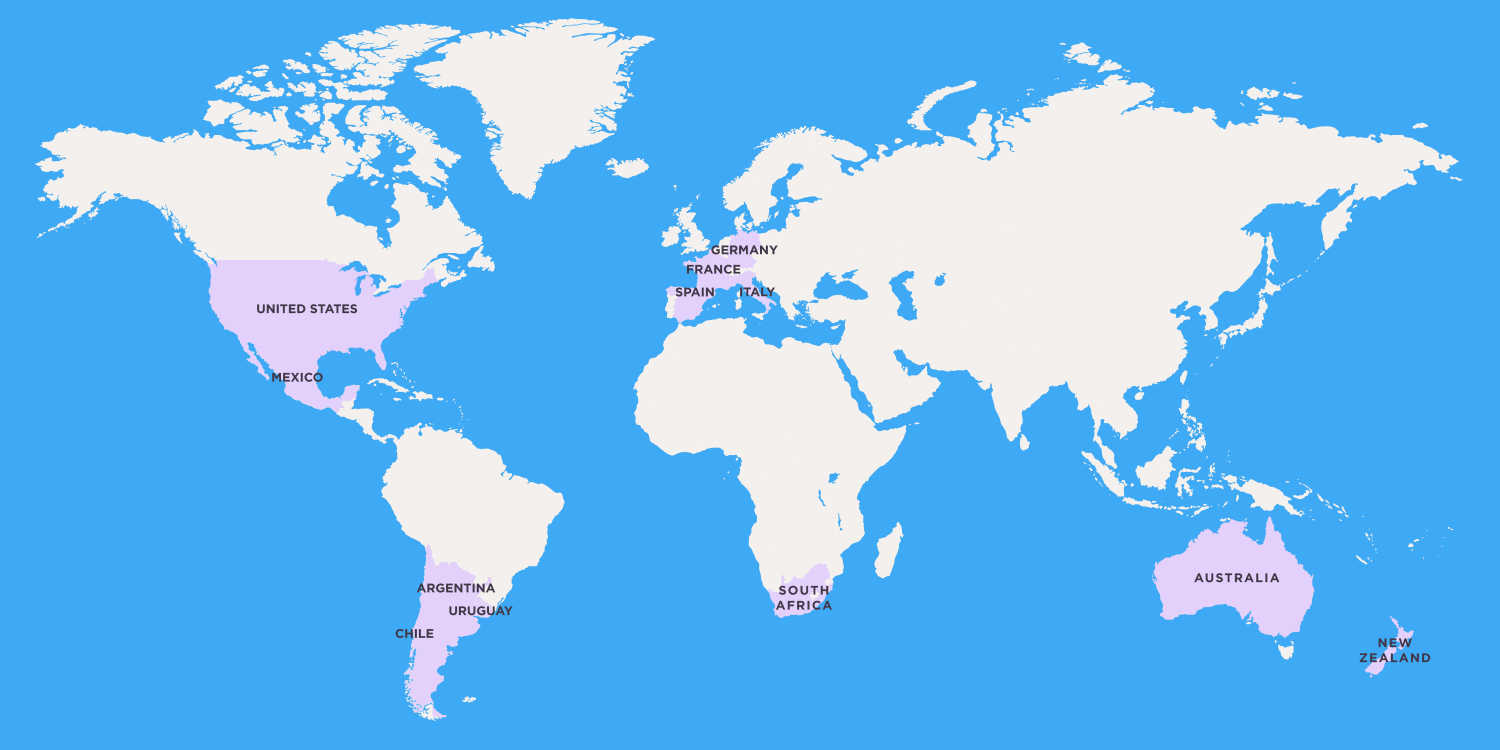Cabernet Sauvignon
Cabernet is the world's most planted grape, and is arguably the most popular
Cabernet Sauvignon is the world’s grape. It is called “King Cab” by some, and an interloper by others. It is all things to many grape farmers, vintners, and wine drinkers. Some dismiss it, some drink nothing else. Regardless of how you feel about Cabernet Sauvignon, it has been helpful to many winemakers the world over. It is grown in almost every wine region on the planet and brings complexity to blends.
Not as difficult to grow as Pinot Noir, but pickier about soil and climate than Merlot, the thick-skinned Cab needs warmth to ripen, but too much heat leads to jammy, unsubtle red wines. It finds its most revered and sought after expressions in Bordeaux where it is blended with Merlot and Cabernet Franc (and occasionally other grapes) to create distinct wines with immense aging potential, and in the robust and heady single varietal Napa Valley Cabernets. The best Cabernet Sauvignons can still be vibrant after a century or more.
Thankfully as winemaking technique has advanced in the last few decades we are seeing more and more accessible young Cabernets. These youthful wines can beguile the senses from the very beginning. The dark fruit scent of blackcurrant is a hallmark of the grape, but other often found notes include black cherry, plum, eucalyptus, mint, tobacco, pencil shavings, and if picked early the scent of green bell pepper.

Take The Quiz
Learning about different wine varietals and regions is fun. Take the quiz now to explore wines matched to your unique palate.
Take The QuizIN THIS ARTICLE:
History of Cabernet Sauvignon
Cabernet Sauvignon (pronounced cab-er-nay so-vin-yawn) berries are dark black with notably thick skins and high acidity. Mistakenly thought to be an ancient grape until the 1990s, it was found that Cabernet Sauvignon was a chance crossing between Cabernet Franc and Sauvignon Blanc in Bordeaux in the 17th century.
Growing in popularity over the ensuing century, Cabernet found a foothold as a blending grape on the Left Bank of the Gironde in Bordeaux in the warm gravel soils. It was adopted across the river and beyond as soon as the vintners realized its potential to round out their blends in years with poor weather.
The grape found its way to Italy and Spain in the early 1800s, and as it gained popularity across Europe it popped up in European colonies across the globe.
Fun Fact
When made and stored properly some legendary Cabernets have been fresh and vibrant at over 100 years old.
We see another big leap forward in the New World in the 1960s and 1970s with winemakers taking the grape much more seriously and making their own interpretations that rival Bordeaux. In fact, in 1976 at the Paris Wine Tasting a California Cabernet from Stag’s Leap beat out their French rivals in what was known as the “Judgement of Paris.” It was a landmark in New World winemaking and showed the Old World that there is fantastic Cabernet to be found outside of Bordeaux. British critic Steven Spurrier even organized a followup judging in 2006 to re-taste the wines and see which has aged the best, and once again California Cabernet took home the top wine, as well as the following four places.
Around this time Italian winemakers began to flout tradition and many abandoned the strict guidelines for producing Chianti and began to explore a new style that would allow them more control over the final product. For many of these winemakers, that meant blending Cabernet with their Sangiovese to mellow out the resulting wine. This “Super Tuscan” movement helped reshape Italian wine.
This surge of popularity in the 1970s also saw the grape gain popularity across the New World, and today there are vines growing in Oregon, Washington, Australia, New Zealand, Central and South America, South Africa, and now in China. It is now the world’s most planted grape, and has truly earned the title: “King Cabernet.”
Fun Fact
The name Sauvignon is close to the French word for wild: “sauvage” and points to one of the early theories for the origin of the grape.
What does Cabernet Sauvignon taste like?
Cabernet Sauvignon is truly an international grape, and it comes in many different styles. There are certain flavors and aromas that are typical throughout, particularly blackcurrant (cassis) and green bell pepper. While bell pepper (sometimes called “green” or “vegetal”) isn’t a common note in many wines, that does not make it a fault in Cabernet. The flavor comes from the phenolics in the grape, which decrease as the grape ripens. In cooler vintages and regions these flavors are more prevalent.
Fun Fact
Cabs from Coonawarra share a special note with Chilean Pinot Noirs: eucalyptus
Cabernet Sauvignon grapes have thick skins which result in high tannin wines. These can take years to mature from a brash and heavily tannic state to a well-integrated and balanced iteration.
Bordeaux wines can exhibit minerality, violets, mint, lead pencil shavings, cedar, or cigar box flavors depending on appellation.
These flavors can be exhibited in New World regions, but as a rule New World Cabernet Sauvignons are jammier and full of more fruit flavors like black cherry and blackberry.
Cabernet Sauvignon Characteristics
Cabernet Sauvignon is a red wine grape that has many standard tastes, but generally performs incredibly well in a blend with other grape varieties. Dependability as a blending grape is one key to Cabernet’s popularity.
Easily cultivated, the Cabernet Sauvignon grape produces fruit that is naturally concentrated and late budding, protecting it from cold snaps in late spring and from bugs in the vineyard that prey upon young vines.
Cabernets are full-bodied with high tannins, and due to the slow ripening of the fruit, the resulting wines are high in acidity and can have significant aging potential.
If a Cabernet Sauvignon is picked too early or is centered in a cooler region it can retain a very green or vegetal characteristic as well as mint and cedar. Warm regions tend to produce “jammy” wines.
Cabernet Sauvignon Nutritional Facts
The nutritional value in Cabernet Sauvignon varies greatly depending on two main factors: alcohol and sugar.
Some Cabernet Sauvignon is sweet, some Cabernet Sauvignon is dry, but generally the more sugar present in a wine, the more carbohydrates.
The alcohol in Cabernet Sauvignon can drastically depending on how ripe the grapes were when harvested, if the winemaker added extra sugar, and how long it was allowed to ferment. Cabernet Sauvignon can contain higher than average levels of alcohol, but much depends on regional styles. Bordeaux wines are regularly 12-13% but warmer regions will produce wines above 14%.
Fun Fact
Cabernet is the most planted red wine grape, but many are shocked that the most planted white wine grape is Airén and not Chardonnay.
How to Serve and Store Cabernet Sauvignon
Serving Cabernet Sauvignon can be done simply. The wine should be opened and allowed to breathe. Enjoy at a temperature between wine cellar and room temperature. If you want to experience the wine through multiple stages we recommend popping the room temperature bottle of Cabernet Sauvignon in the refrigerator for 15 to 30 minutes before serving, but this is all personal preference. Enjoy your wine how you like it.
Once your wine is slightly cooled it is time to open the bottle. Most likely you will need a standard corkscrew, but if you have a particularly old bottle of wine, you might prefer to use a two-prong cork puller.
Young Cabernet likes to be decanted. Open the wine and decant two hours before enjoying. If you are drinking an older bottle (10+ years) or one that is particularly complex ensure that you are pouring gently into the decanter to avoid agitating the sediment.
Cabernet Sauvignon should be stored in a cool place that does not receive direct sunlight, and preferably in a wine refrigerator or cellar. 55 degrees Fahrenheit is the median temperature wine should be stored if you wish to age the bottles. What matters most is consistency. Do not store your Cabernet Sauvignon in a place that receives direct sunlight, heat, or too much humidity.
What to Pair with Cabernet Sauvignon
Pairing wine has some general rules, but we think the most important rule is to drink Cabernet Sauvignon with the food you like. With Cabernet Sauvignon that is bold and assertive, it is important to know that it can overwhelm lighter flavors, so pair with rich meats.
Cabernet Sauvignon Wine Regions Around the World
Cabernet Sauvignon is truly an international grape and grows all over the winemaking world. The styles vary greatly by region and by producer. Here is a brief overview of where it is growing, and broad tasting notes associated with each region.
France:
The rise of Cabernet Sauvignon started in Bordeaux, and grew in popularity throughout the Left Bank especially the Médoc and Graves. Despite being the most planted wine grape in the world, it is not the most planted grape in Bordeaux and is used in different percentages in the famous Bordeaux blends. These Bordeaux wines are known for varying unique flavors that express the terroir, or sense of place, of the vineyards.
Saint-Estèphe and Pessac-Léognan are famous for producing Cabernet wines with strong minerality. Margaux wines can taste like a field of violets. Pauillac wines can smell like pencil shavings. Saint-Julien is full of woodsy flavors like cedar and cigar boxes. Graves is characterized by strong blackcurrant flavors, which is a signature flavor of most Cabernet Sauvignon, but there it is more concentrated and robust.
Elsewhere in France wine lovers will find the grape growing throughout the south where it is sometimes found as a single varietal wine.
Italy:
Introduced to Piedmont in the early 1800s, Cabernet Sauvignon has a long history as a blending grape in the country where it is most often found in the contentious “Super Tuscan” blend, or with Nebbiolo or Sangiovese to round out the highly tannic and sometimes harsh grapes.
Cabernet Sauvignon from Tuscany features the famous blackcurrant aromas and flavors, but also as a warmer region than Bordeaux it can have more black cherry and sweetness as well as high acidity and alcohol.
Cabernet is most popular in the previously mentioned regions, but it is found all over the country. Some other notable regions that feature Cabernet Sauvignon are Lombardy, Emilia-Romagna, the Veneto, Friuli-Venezia, and Alto Adige (Sudtirol).
Spain:
Spain features Cabernet Sauvignon plantings throughout the country and especially in Rioja (even though it is not an officially recognized Rioja grape) and Penedes where it is blended with Tempranillo.
United States:
The fate of Cabernet Sauvignon as a single varietal wine is tied hand-in-hand with California winemaking. California Cabernet from Stag's Leap Wine Cellars won the infamous “Judgement of Paris” and beat out the French wines again at the 30-year follow-up judging.
Today Napa Cabernet is synonymous with big, bold flavors, rich tannins, and high alcohol levels with similarly big scores from critics like Robert Parker. St. Helena and Stags Leap District AVA, in particular, are the most famous Napa appellations for Cabernet Sauvignon. Sonoma’s Alexander Valley is another region known for producing high-quality Cabernets, but there are great examples that can come from all over the state. Other good California Cabernet comes from Paso Robles and other Central Coast vineyards.
Washington State Cabernet Sauvignons have become much more high-quality in the past few years with riper fruit coming from improved vineyard management. The best examples come from the Columbia Valley and are generally bright and fruity, but there are examples of dark and pensive wines.
Australia:
Around the same time California Cabernet came of age, the winemakers in Coonawarra were starting to make finely structured, blackcurrant filled wines that featured just a hint of mint to liven the tastes. It quickly grew and came into its own around the Margaret River, Yarra Valley, Clare Valley, Barossa, and the McLaren Vale.
Australian Cabernet Sauvignon winemakers are much closer in spirit to Bordeaux than California and search to showcase terroir as opposed to the winemaker's hand.
New Zealand:
The most famous region in New Zealand for Cabernet Sauvignon is Hawkes Bay and the best examples are blended with a bit of Merlot, but a wine lover is still going to find better quality with a New Zealand Pinot Noir.
South America:
Cabernet Sauvignon is grown all over the world including Central and South America: Mexico, Uruguay, Brazil, Chile, and Argentina all produce good quality Cabernets. Chile in particular is producing Cabernets in the Maipo Valley that are beginning to show exceptionally well.
South Africa:
At the end of Apartheid South Africa began to experiment with Cabernet Sauvignon and it is now the most planted red varietal in the country. Wine lovers can find all styles of Cabernet from the country.

Take The Quiz
Learning about different wine varietals and regions is fun. Take the quiz now to explore wines matched to your unique palate.
Take The QuizIN THIS ARTICLE

WinePrint™ by Firstleaf
Are you looking to learn more about your wine preferences? Check out our Wine Print for an in-depth look at your personal tasting profile. Discover your favorite wines, varietals, regions, and tasting notes and get personalized recommendations wherever you are.
Learn More
